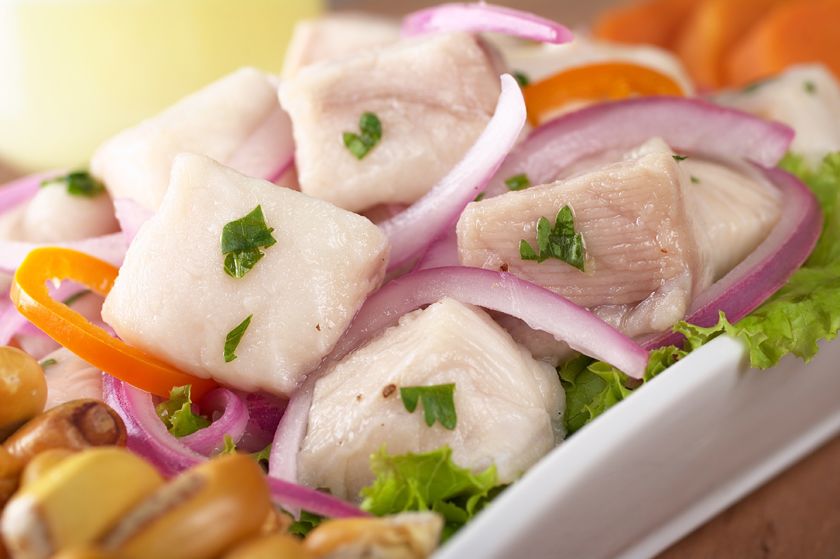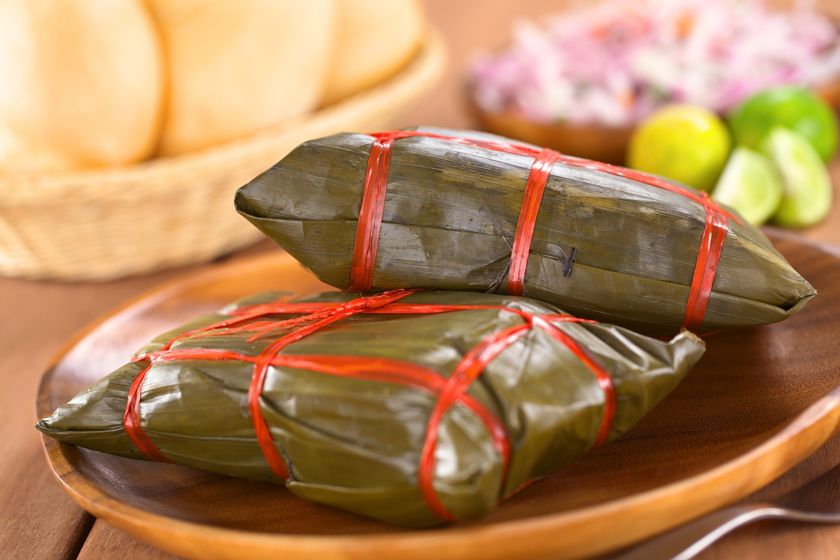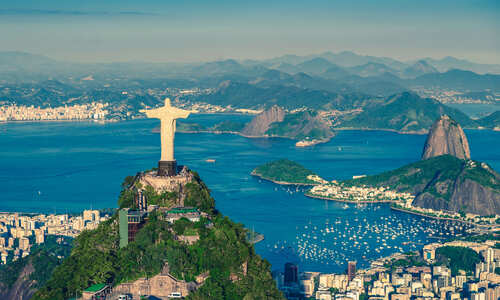Article content
13 February 2013 by Alex Stewart
Spanish and Portuguese conquistadors stamped their authority over most of Latin America, but in the indigenous cuisine they met their match. The result was one of history's greatest culinary shake-ups.
pre-columbian food | ceviche | tamales | bite-size diversions
From the Maya in the north to the Inca in the south, Central and South America's indigenous cuisine is succulent and delicious, delighting the taste buds of the conquering conquistadors.
Small wonder then that the newly arrived colonists diplomatically adapted local traditions to adopt an all-embracing fusion food. The beef and lamb, rice, cheese, tomatoes, garlic, vinegar and wine of the Europeans mingled with the edible delights they discovered in the New World: maize (corn), root vegetables like potatoes, fiery chillies, a tantalising variety of fish and hitherto unknown fruits that the wildly differing climatic zones had fashioned into a thousand shapes, colours and tastes.
African slaves, who were typically given less-appealing cuts of meat and so concocted adventurous seasonings to make meals palatable, introduced the likes of ginger, cashews and dried smoked fish. More recent fragmented settlers like Argentina's Welsh community got in on the action by making tea and cakes a national afternoon institution.
The familiar staples of Latin American cuisine stem from maize, cultivated since ancient times. The tortilla, a cornflour dough cooked on a circular griddle, is a common base or wrap for a meal. A combo of beans and rice is so popular it has become a national dish in some countries. Chicken is Latin America's main meat, but there is also diverse seafood, and possibly the world's best selection of freshwater-fish dishes.
Latin America's topographical variation means culinary variety is often as great within countries as between them. Ask citizens of Colombia, Ecuador or Peru to name their typical dishes and they will give you three sets of answers: one for the coast, one for the mountains and one for the jungle. This means that guinea pig or turtle can liven up menus along with cooking styles like the Inca pachamanca method: a bake inside a heap of hot stones.
And to finish? Latin Americans have a notoriously sweet tooth, and the most distinctive flavouring is the caramellike dulce de leche, gracing desserts region-wide.
Pre-Columbian Food

From cuy to ceviche
Back in preconquistador days, Latin America had no cows, sheep or pigs: llama and guinea pig were South America's meaty alternatives. In Central America seafood was often relied upon, and marinated or dried for preservation. Today, cuy (guinea pig) and ceviche (lime-marinated fish) are two of the region's famed foods.
Indigenous cuisine relied extensively on root vegetables. Peru is the original home of the potato, and the fellow native root cassava is also commonly used in Latin American food. The maize of the Mayans and Incas still forms the bulk of the region's cuisine - from straightforward corn on the cob (smeared these days in butter, mayonnaise, cayenne, paprika or cheese) to tortillas (used to wrap everything from meat to beans) and the culturally important corn-fermented chicha drink.
Also crucial to ancient diets were grains and pulses, still blended into stews and soups today. It's possible that the nutrition-rich grains quinoa and cañahua, only recently discovered by the outside world, were as important to the success of ancient empires as maize.
But the real power of pre-Columbian cuisine is delivered courtesy of those who make it. Food purchasing is a memorable experience: peoples like the Maya and Quechua still wear traditional dress, often speak only their own language, and cook more or less as they've cooked since the mists of time.
Ceviche

There's no better example of fusion cuisine from Guatemala to Chile than this marinated fish dish: raw fish 'cooked' in a lime marinade with red onion, garlic and chilli flakes, and served alongside sweet potato and clumps of corn on the cob.
Ceviche's popularity has spread all along Latin America's Pacific coast, but Peru, with a national holiday in honour of the fishy dish, is usually deemed its birthplace. Marinades were used by the Inca, but with maize-based chicha rather than lime, which was introduced by the Spanish. Corvina, the fish of choice used, has been consumed across the region for millennia, but it was a Japanese chef, Dario Matsufuji, who pioneered a new recipe in the 1970s that reduced marinating time from hours to minutes and did wonders for boosting the cooking technique's popularity.
Origins of ceviche are a hot topic. Did it derive from the Quechua word for the dish, siwichi or from the Spanish escabeche (a fish or meat dish with an acidic marinade)? Or could Arabic peoples have had a hand in its origins, seeing as sakbāj in Arabic means 'meat cooked in vinegar'?
But it's the way the fish absorbs the flavours of the other ingredients to produce an assault on the eyes as well as the taste buds that makes it so special. Take Peruvian ceviche: crisp red onion and the country's distinctive, flavoursome yellow-red chilli, aji limo, adding to the zing of the lime to counteract the soft, juicy sensation of the corvina as it breaks apart inside your mouth.
|
Where to eat: ceviche The ceviche family is extended indeed. Ecuadorians prefer a tomato-heavy version while Panamanians eat ceviche in a pastry shell. Replacements for the corvina could be freshwater dorade in the Amazon and shrimp or lobster among Central Americans. Perhaps most distinctive of all, folk in El Salvador use black clams. |
Tamales

It's a safe bet that street-food junkies traversing Central or South America will inevitably sample tamales before too long. Dating back to the Mayan empire that stretched from Mexico to Honduras, this steamed maize-based delight mixed with meat or fish and served in a plantain leaf casing is among the most popular portable foods hereabouts.
Variants fed Inca armies and Amazon tribes-people on river trips, and were soon gobbled up by conquistadors too. The heart of the Mayan world, Guatemala, is characterised by its tamale diversity, while fillings region-wide veer from almonds or prunes to boiled eggs. You can make your version of tamales by pressing (rolling) a tortilla dough until papery thin (the thinner the better). Fill the small square with ingredients you have to hand, for example beef or pork with a hint of mole sauce, or simply some shredded pork that has been cooked with garlic and chilli; let your imagination run and add fruit or spices such as cumin or cinnamon. Fold like an envelope to seal and place fold-side down on a cornstalk leaf that has been soaked (and thus softened) overnight.
Wrap each leaf securely - you can tie an extra strip around the tamale for presentation purposes - and steam the parcels for 10 to 15 minutes or until the dough is cooked. Consume greedily without delay. If cornstalk leaves aren't available, an alternative is to wrap the tamales in banana leaves. Or travel to Latin America to try the real thing.
|
Where to eat: tamales Nicaragua's pride and joy is its very own tamale, out-trumping even Mexico's versions. Nacatamales are larger than Mexican tamales and come with meat, vegetables (potato and tomato), olives and rice along with the corn masa (dough). |
____________________________________________________________________
Bite-size diversions
Fish cooked in lime juice, the planet's best chocolate, strange fruit from the world's most biodiverse forests...here are Latin America's most sense-enriching foodie experiences.
Honduras
Savouring Central America's best seafood on the idyllic Bay Islands, where their unique Caribbean influence contributes something special to delicacies like conch chowder (conches being sea snails).
El Salvador
Chowing down at a pupusería, a Salvadoran eatery that specialises in the country's eclectic cheesy, doughy snack, the pupusa: a maize flour disc-shaped tortilla packed with cheese, frijoles (refried beans) and chicharrón (fried pork).
Costa Rica
Slurping up one of the world's greatest caffeine fixes in the region that makes half of the planet's coffee, and staying a while on to enjoy the local produce on a shaded coffee plantation in Finca Rosa Blanca, near Heredia.
Ecuador
Touring a cacao plantation in the country producing the highest percentage of top-quality chocolate, or indulging at an affiliated chocolate shop like Quito's Kallari Café.
Amazon Region
Immersing yourself in the vivid furore of an Amazon market, where you can browse among ingredients that include everything from diverse rainforest fruits and berries to weird-and-wonderful freshwater fish.
Peru
Partying in one of the region's most cuisine-rich cities at Lima's massive food festival, Mistura, which happens each year in September. Among the delicacies on offer here you might find cuy (guinea pig), ceviche (citrus-marinated fish) or juane (steamed rice with fish or meat trussed up in a jungle vine).
Bolivia
Acclimatising to mountainous Bolivia with (legal) Andean coca leaf tea - a mild stimulant (similar to tea or coffee) said to help prevent altitude sickness - that will leave you feeling sky-high.
Argentina
Sampling the heated debates, wicked coffee and effortless class of San Telmo, the traditional cafe district of Buenos Aires. Sit and linger until teatime: a custom introduced by the British, which is celebrated with cakes concocted with dulce de leche (caramel-like sweetened milk).
Brazil
Freshening up with juice from a Rio juice bar, often concocted with rare jungle fruits and packed with guarana, an energy-boosting bean with twice the caffeine levels of coffee.
Chile
Partaking of this leading Latin American wine-growing region with a vineyard tour and a glass of rich Maipo Valley cabernet sauvignon in pastoral Valle Central.
____________________________________________________________________
This guest article was contributed by leading publisher Lonely Planet, from their sumptuous Food Lover's Guide to the World, which presents a lifetime of eating experiences that will lead you from one end of the globe to the other.
Take your taste buds on a tour around the world and then give us a call once you've wheted your appetite for your next culinary adventure.
.







